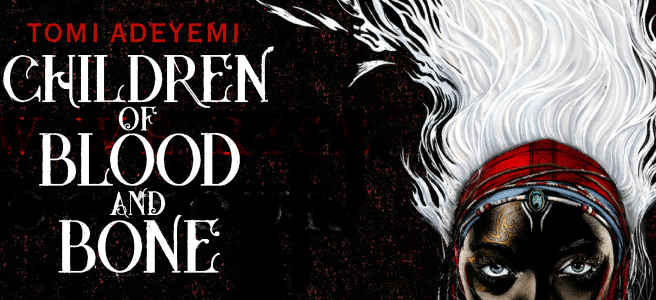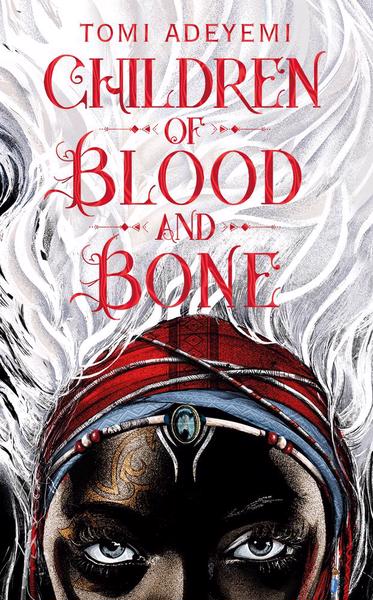
Children of Blood and Bone
by Tomi Adeyami
Published March 6, 2018
537 pages, Henry Holt & Co.

“We are all the children of blood and bone.” Tomi Adeyemi’s West Africa inspired Children of Blood and Bone, a New York Times bestseller and the center of one of the biggest YA publishing deals ever, is a critically triumphant debut. Written in response to the various acts of police brutality throughout the years, Adeyemi’s fantasy novel adequately tackles the idea of equality—or rather, the lack of it. The characters portray a strikingly familiar narrative, one of violence, oppression, rights, and, more importantly, who deserves those very rights.
In a land once riddled with magic and maji, those who were born with ashe in their veins and the ability to use magic are now subjected to abuse and fear. After the Raid, where powerful maji were dragged from their homes and killed, magic was eradicated with no hope of ever returning. Zélie Adebola loathes the king, and has ever since her mother was taken before her eyes during the Raid, but the white hair that marks all dîviners as maggots adorns her head as well, sentencing her to a life of oppression under a ruthless tyrant. While trying to trade for gold in the royal city of Orïsha, Zélie finds herself aiding a runaway princess named Amari. This one act of kindness triggers a chain of events as Zélie, her older brother Tzain, and Amari begin a journey to revive the magic that once flowed through the lands. But they are pursued by none other than Prince Inan, Amari’s brother and Captain of the Royal Guard, who will travel to the ends of Orïsha to retrieve his sister, destroy the possibility of bringing magic back, and kill the white-haired girl with the sea-salt soul.
After reading many fantasy books such as this one, I was prepared for the extensive worldbuilding and the emotional rollercoaster I would endure. This book did not disappoint—I did find myself cursing the characters’ actions and crying throughout the course of the novel. That being said, while Children of Blood and Bone has been labeled a magnificent work and a phenomenon, for me this novel fell flat.
To start on the small quibbles: the pacing and worldbuilding. Having read novels that are inspired by foreign areas, I’m no stranger to different languages and words of different origin interspersed throughout the work. Authors such as Chinua Achebe and Leigh Bardugo have done this very well, and Tomi Adeyemi is no different. But the wordbuilding is a stumbling block regardless. Various species of animals such as lionaires and panthenaires have little to no introduction, and continue to be a mystery throughout the novel, though they are used as the main forms of transportation for the protagonists and the guards that pursue them. In addition to this, the cities aren’t developed as fully as possible, leaving a partial landscape within the mind and more to be desired. Still, the novel is navigable despite these small issues, but at different paces. The first hundred and fifty pages are slow, despite the chases that ensue within them, and the pace continues to vary from there. As a reader, you are not thrown into action, at least, enough to keep you interested for an over five hundred page novel. But, the pace picks up at the halfway mark, so those that had the strength to push through are definitely rewarded.
Now, to the most glaring issues I had with the novel: the characters and the plot. Seemingly the most important parts of any work, I found both to have their faults as well as triumphs. The plot, which has less to touch on, moved well and was easy to understand, but I found myself not truly caring whether or not they accomplished their goal as we neared the end. The overall idea didn’t grip me as much as the characters did, which leads me to the largest issue I had. These characters drove the novel, and were highly compelling, no doubt. But, in the sense of their lack of dynamicness, this main point was where the novel lost its hold. The best character, in my opinion, is easily Inan. Though not the “main” character (Zélie, Amari, and Inan all have perspective chapters throughout the course of the book) per se, the reader can actively see how he changes, how his thinking adapts to those around him, and how he is influenced by those very people. His arc, while not complete due to the two other books that have yet to been released, is one that drives the novel forward in comparison to Zélie, who the story is centered around. While she has her moments, her ideals and prejudices stay stagnant in a novel that attempts to tackle the very idea of equality and finding peace. The lack of a compelling arc for her character is a detriment to the story she is supposed to propel forward. It should be said that Amari is dynamic in the sense that she changes early on in the novel, but stays static enough afterwards to write off as neutral. Though I thoroughly enjoyed the characters as I read them, for sure, after ruminating on them for a span of time, I found that the only one I could truly pinpoint as interesting and dynamic enough to hold my attention was Prince Inan,
Lastly, and without spoilers, a bone to pick with the ending: I don’t understand. There are two more books in the trilogy that are supposed to be released in the coming years, so I don’t expect a full resolution of course, but the end left more than something to be desired. Coming off a strong climax and various heart wrenching scenes, the ending was such a low point for the novel that it caused me to question what I had read and deemed great leading up to it. It left me confused and disappointed after the effort that had been put in to reach that point, and absolutely staunched the tears I had been shedding beforehand.
Having given those notes, Children of Blood and Bone did something. It mirrored the things we see on the nightly television, just hidden beneath a West African world of magic and adventure. It had its triumphs, and any book that causes tears has something special. Hence, why I don’t regret reading it, and why I believe I will give the other books in the trilogy a try, but I definitely won’t be racing to get them. Out of five, I’d rate it a three and a half, and would selectively recommend it to those that had elevated interest in the style or genre and, most importantly, have the wonderful virtue of patience that I lack.
